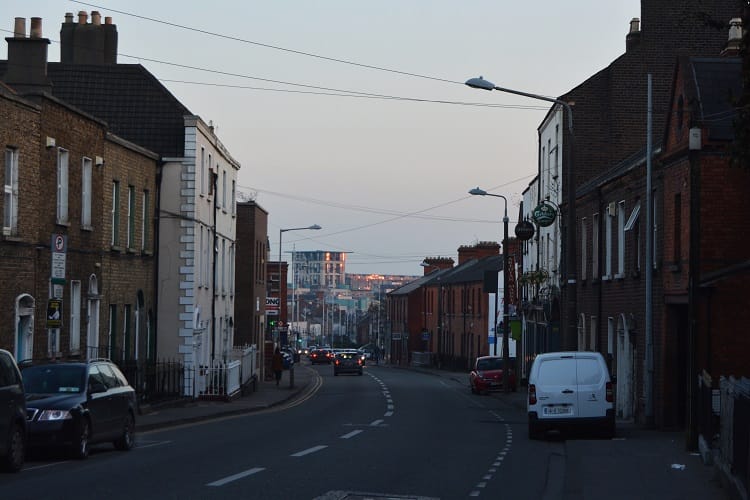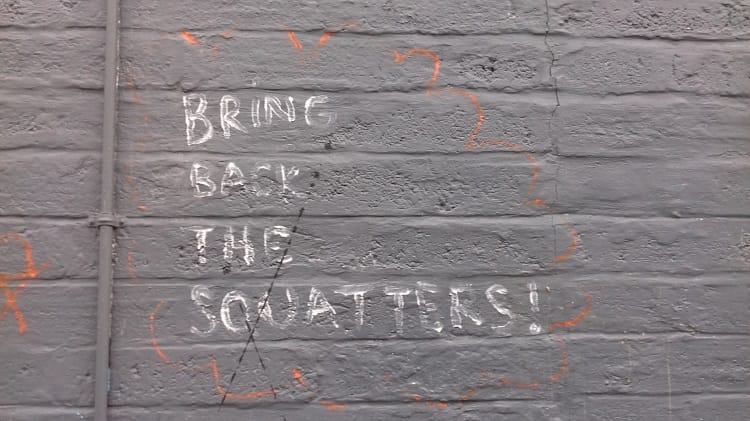What’s the best way to tell area residents about plans for a new asylum shelter nearby?
The government should tell communities directly about plans for new asylum shelters, some activists and politicians say.
Stoneybatter could have rooms for thousands of students in a couple of years’ time – and some locals claim that’s too many in one place.

It’s the first day of the term at DIT’s Grangegorman campus and a few groups of students are out in the sunshine, milling about and playing football and snickering at a couple of Gardaí on the beat.
It might sound idyllic but getting there is a bit of a nightmare for Michael Murphy from Co. Laois.
He’s in his first year studying early childhood education at DIT and is one of the 1,000 or so students among the first to take classes in the former St Brendan’s Hospital.
“I leave home about six o’clock,” he said. “I have to get a train at five to seven.”
From his parents’ house near Abbeyleix, Murphy heads to the mainline train station at Portlaoise for the 6:54am service to Heuston. That gets in just before 8am, and he usually hangs out at the station for a little before taking a stroll over to Grangegorman for classes starting at 9am, he said.
His classmate Kieran Pearson looked horrified. He only has to come across town from Harold’s Cross.
It’s a monster of a commute, and Murphy is ready to put an end to it. But at Griffith Halls of Residence, the only student dorms with places set aside for DIT students, prices start at €600 a month – and that’s for a place in a shared bedroom.
Murphy works in a shop at weekends and reckons he can afford just €400-€450 as a monthly budget, putting any of the dedicated student housing on offer in the city well out of reach.
A report by the Higher Education Authority in 2015 warned there was a major gap in the supply of student housing.

At that time, there was a demand for 57,104 beds, but just 31,216 available nationwide. It predicted investment of €1 billion in student housing to bring total supply to 43,496 – but said this would do little to close the gap.
Demand is expected to rise because the overall number of students is predicted to increase dramatically over the next seven years, rising from about 160,000 to over 192,000 by 2024.
Funding cuts to third-level budgets since the financial crash have also led colleges to recruit more students from overseas to fill their coffers – the number of non-EU students enrolled in Irish higher-education institutions has almost doubled since 2010 – bringing in a cool €177 million in tuition fees to cash-strapped colleges.
The Department of Education is aiming to increase the total number of international students by a third again between now and 2020.
In the last two months, Dublin City Council has given permission for two developments of purpose-built student housing near DIT’s Grangegorman campus, with room for 774 students.
It is currently considering applications for four more schemes, which would have room for another 1,410 students. Another 2,000 beds are eventually planned on campus.
According to Green Party Councillor Ciarán Cuffe, who lectures in planning at DIT, there are development projects totalling at least 6,000 student bedspaces in varying stages of development across the north inner city.
Some locals aren’t entirely pleased with the level of development.
Speaking to the Northside People this week, former Labour minister Joe Costello branded development in the north inner city a “gold rush”, claiming the “sheer density of such accommodation in a small area will create a huge imbalance with the existing residential population, place pressure on local services and give rise to a host of problems in local neighbourhoods”.
The owners of the Park Shopping Centre on Prussia Street have applied to redevelop the centre with a scheme that would have room for 541 student beds. In the meantime, it’s as busy as ever.
“I haven’t made up my mind about it,” said Sorcha Brennan, whose two-month-old slept soundly as she queued for an ATM there on Monday. “I really don’t have a problem with students, but there needs to be more social and affordable housing for locals too.”
She remembers her own adventures in the Dublin rental market as a student in the 1990s. “Some of the places I would have looked at were horrific,” she said.
Purpose-built student housing is generally a good idea, she thinks. “It seems to be a very profitable way to do development, but prices have gone up a lot in the area. It’s got a great community feel and it’d be a shame to lose it.”
“The reality is we’re about to start a really ambitious construction phase in the DIT Grangegorman project which will result in about 20,000 students up in Grangegoorman every day,” Cuffe said.
“A certain portion of those will want to live reasonably close to campus. If you look at two to three thousand bedspaces for 20,000 students – that seems reasonable enough to me,” he said.
“I’d be cautious on turning down planning permission for housing in the middle of a housing crisis. I think each application has to be looked at on its merits,” he added.
Ray McAdam, a Fine Gael councillor who lives in Stoneybatter, is more concerned.
“I welcome the provision of purpose-built student accommodation. It is necessary and the provision of student accommodation will actually help provide some level of relief on the rental market in Stoneybatter and in the north-west inner city,” McAdam said.
“What I do have a problem with is the over-proliferation of one type of development in a particular district or location. I would contend that this overproliferation of one kind of development goes against the spirit and objectives of the city development plan.”
McAdam is hoping stricter planning rules can check the growth of student housing. Currently, planners are required to take note of other student housing projects within 250 metres of a new site. McAdam wants this study radius increased to a kilometre in all directions – a move backed by Cuffe.
McAdam also intends to put forward a motion that would force city council management to bring in an area development plan for Stoneybatter as soon as possible to bring in stricter zoning conditions.
“Residents are not opposed to development.” McAdam said. “They welcome development of the sites, but they want to make sure that the development proposed blends in with the local community – not stands out like a sore thumb.”
McAdam worries that the supply of major strategic sites in the Stoneybatter area is going to be used up by student accommodation, leaving little opportunity for ordinary residential housing which might suit families in the area – and crucially, keep prices down.

The largest student development being planned in the area is at the former Squat City site at the corner of Brunswick Street and Grangegorman Lower, where Global Student Accommodation (GSA) is building living space for 571 students. GSA trades under the Uninest brand and has two more sites under development in Newmarket and Gardiner Street.
It also operates the Broadstone Hall block on Constitution Hill. It’s a major player, and the firm believes the development will take some of the pressure off prices in the area. “Students will naturally gravitate to live near the new DIT campus,” GSA’s projects director Aaron Bailey said.
“Having the option of well-managed purpose-built student accommodation will reduce the burden currently being placed on traditional, privately rented houses and apartments. Providing this new style of accommodation could release hundreds of housing units for occupation by families and other non-student residents.”
Says McAdam: “We have to make sure that we have the long-term interests of a community in a neighbourhood in mind when we’re making decisions about developments that are going to be there for the next 50 years of so. We saw too much of the wrong type of development in the boom years and we can’t make the mistake of going down that path again.”
Cuffe is concerned that developments built with lower space requirements won’t be flexible enough for future needs.
“Given that we set lower space standards for students, what happens if the students don’t materialise? Can we convert these houses into decent houses for other people?” said Cuffe.
“I think we should make sure that the owners and developers of these units aren’t allowed to turn them into regular housing without meeting the standards that we apply to conventional housing,” he added.

Critics of student housing development have been reluctant to brand future neighbours as rowdy lager louts, but it’s clear there are major concerns bubbling to the surface about the future of the neighbourhood.
Back in Grangegorman, Michael Murphy and Kieran Pearson understand the concerns. They know what the general perception of students is.
“If I was older and had my own house I probably wouldn’t want students living beside me,” Pearson said.
Nearby, two young girls out with their mam in the landscaped campus have discovered that the towering walls of the old asylum return an excellent echo.
“There’s an ECHO!” one of them yelps. Spring must be infectious: the other girl replies “I! LOVE! YOU! IN THE WHOLE! WORLD!”
Get our latest headlines in one of them, and recommendations for things to do in Dublin in the other.